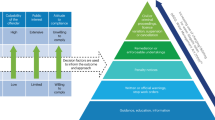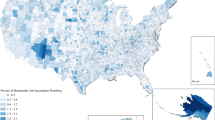Abstract
Water crises constitute a challenge for humanity. Uncertain supply and growing demand are driving higher water theft, particularly by agricultural users who account for approximately 70% of global use. However, research into water theft is underexplored in all disciplines. This paper provides a conceptual framework and modelling approach designed to improve understanding of both individual and institutional barriers to water theft. The framework and model explore how effective detection, prosecution, conviction and penalties can be assessed. Three case studies test the validity of our framework. Our findings suggest that while individuals and companies may be responsible for the act of theft, the phenomenon reflects a systematic failure of arrangements (political, legal, institutional, and so on). In addition, when regulators fail to understand the value of water, inadequate prescribed penalties increase the risk of theft. We invite others to test our framework, apply our model and engage in a wider conversation about water theft.
This is a preview of subscription content, access via your institution
Access options
Access Nature and 54 other Nature Portfolio journals
Get Nature+, our best-value online-access subscription
$29.99 / 30 days
cancel any time
Subscribe to this journal
Receive 12 digital issues and online access to articles
$119.00 per year
only $9.92 per issue
Buy this article
- Purchase on Springer Link
- Instant access to full article PDF
Prices may be subject to local taxes which are calculated during checkout



Similar content being viewed by others
Data availability
The data that support the findings of this study are available in the Supplementary Information or by request from the authors.
References
Strategic Report: Environment, Peace and Security: A Convergence of Threats (UNEP and INTERPOL, 2016).
Felbab-Brown, V. Water Theft and Water Smuggling: Growing Problem or Tempest in a Teapot? (Brookings Institution, 2017).
Kohlberg, L. Essays on Moral Development: The Psychology of Moral Development Vol. 2 (Harper & Row, 1984).
Akers, R. L. Deviant Behavior: A Social Learning Approach (Wadsworth, 1973).
Tyler, T. R. Why People Obey the Law: Procedural Justice (Yale Univ. Press, 1990).
Becker, G. S. Crime and punishment: an economic approach. J. Polit. Econ. 76, 169–217 (1968).
Vandermeer, C. Water thievery in a rice irrigation system in Taiwan. Ann. Assoc. Am. Geogr. 61, 156–179 (1971).
Weissing, F. & Ostrom, E. in Game Equilibrium Models (ed. R. Selten) 188–262 (Springer, 1991).
Holley, C. & Sinclair, D. A new water policy option for Australia? Collaborative water governance, compliance and enforcement and audited self-management. Australas. J. Nat. Resour. Law Policy 17, 189–216 (2014).
European Report on Water Crimes (RECEE, 2017).
Wade, R. Managing a drought with canal irrigation: a South Indian case. Agric. Adm. 17, 177–202 (1984).
Trawick, P. B. Successfully governing the commons: principles of social organization in an Andean irrigation system. Hum. Ecol. 29, 1–25 (2001).
Castilla-Rho, J. C., Rojas, R., Andersen, M. S., Holley, C. & Mariethoz, G. Social tipping points in global groundwater management. Nat. Hum. Behav. 1, 640–649 (2017).
Castilla-Rho, J., Rojas, R., Andersen, M., Holley, C. & Mariethoz, G. Sustainable groundwater management: how long and what will it take? Glob. Environ. Change 58, 101972 (2019).
Wade, R. The management of common property resources: finding a cooperative solution. World Bank Res. Obs. 2, 219–234 (1987).
De Stefano, L. & Lopez-Gunn, E. Unauthorized groundwater use: institutional, social and ethical considerations. Water Policy 14, 147–160 (2012).
Greiner, R., Fernandes, L., McCartney, F. & Durante, J. Reasons why some irrigation water users fail to comply with water use regulations: a case study from Queensland, Australia. Land Use Policy 51, 26–40 (2016).
Keane, A., Jones, J. P. G., Edwards-Jones, G. & Milner-Gulland, E. J. The sleeping policeman: understanding issues of enforcement and compliance in conservation. Anim. Conserv. 11, 75–82 (2008).
Laffont, J.-J. The new economics of regulation ten years after. Econometrica 62, 507–507 (1994).
Ray, I. & Williams, J. Locational asymmetry and the potential for cooperation on a canal. J. Dev. Econ. 67, 129–155 (2002).
Adamson, D., Loch, A. & Schwabe, K. Adaptation responses to increasing drought frequency. Aust. J. Agric. Resour. Econ. 61, 385–403 (2017).
Steinfeld, A. Cannabis and water regulation: sorting through the weeds. Water Rep. 181, 1–11 (2019).
DeBoe, G. & Jouanjean, M.-A. Digital Opportunities for Better Agricultural Policies: Insights from Agri-Environmental Policies (OECD, 2018).
Ostrom, E. Governing the Commons: The Evolution of Institutions for Collective Action (Cambridge Univ. Press, 1990).
Galdón, C., Jara, Y., Leralta, J. M. & Vived, A. La Tierra Protegida: La Junta de Andalucía Otorgó Subvenciones Europeas a Fincas en Zona Protegida de Doñana (Universidad Rey Juan Carlos and Unidad Editorial, 2017).
Criminal, Civil and Administrative Penalties for White Collar Crime: Final Report (Senate Standing Committees on Economics, 2018).
O’Donnell, E. & Talbot-Jones, J. Creating legal rights for rivers: lessons from Australia, New Zealand, and India. Ecol. Soc. 23, 7 (2018).
Meehan, K. Disciplining de facto development: water theft and hydrosocial order in Tijuana. Environ. Plan. D 31, 319–336 (2013).
Eckstein, H. in Case Study Method: Key Issues, Key Texts (eds Gomm, R. et al.) Ch. 6 (Sage, 2000).
Noor, K. B. M. Case study: a strategic research methodology. Am. J. Appl. Sci. 5, 1602–1604 (2008).
Gomm, R., Hammersley, M. & Foster, P. Case Study Method: Key Issues, Key Texts (Sage, 2000).
Khan, S. & VanWynsberghe, R. Cultivating the under-mined: cross-case analysis as knowledge mobilization. Forum Qual. Soc. Res. 9, 34 (2008).
Baland, J.-M. & Platteau, J.-P. Halting Degradation of Natural Resources: Is There a Role for Rural Communities? (FAO, 1996).
Ragin, C. C. in The Comparative Political Economy of the Welfare State (eds Janoski, T. & Hicks, A.) 299–319 (Cambridge Univ. Press, 1994).
Marx, A., Rihoux, B. & Ragin, C. The origins, development, and application of qualitative comparative analysis: the first 25 years. Eur. Political Sci. Rev. 6, 115–142 (2014).
Velasquez, M. & Hester, P. An analysis of multi-criteria decision making methods. Int. J. Oper. Res. 10, 56–66 (2103).
Panthi, K. & Bhattarai, S. A framework to assess sustainability of community-based water projects using multi-criteria analysis. In Proc. First International Conference on Construction in Developing Countries (ICCIDC–I) (UET Taxila, 2008).
Hasson, F., Keeney, S. & McKenna, H. Research guidelines for the Delphi survey technique. J. Adv. Nurs. 32, 1008–1015 (2000).
Strand, J., Carson, R. T., Navrud, S., Ortiz-Bobea, A. & Vincent, J. A. “Delphi Exercise” as a Tool in Amazon Rainforest Valuation (World Bank, 2014).
Hajkowicz, S. & Collins, K. A review of multiple criteria analysis for water resource planning and management. Water Resour. Manag. 21, 1553–1566 (2007).
Uphoff, N. & Wijayaratna, C. M. Demonstrated benefits from social capital: the productivity of farmer organizations in Gal Oya, Sri Lanka. World Dev. 28, 1875–1890 (2000).
Adamson, D., Mallawaarachchi, T. & Quiggin, J. Water use and salinity in the Murray-Darling Basin: a state-contingent model. Aust. J. Agric. Resour. Econ. 51, 263–281 (2007).
Chambers, R. & Quiggin, J. Uncertainty, Production, Choice and Agency: The State Contingent Approach (Cambridge Univ. Press, 2000).
Götze, U., Northcott, D. & Schuster, P. Investment Appraisal: Methods and Models (Springer, 2008).
Acknowledgements
D.A. recognizes funding from the Australian Research Council via a DECRA grant (DE160100213) which assisted with some of his time. Advice from M. Shanahan for critical early insights into the theory, which informed early drafts of the paper, is also greatly appreciated.
Author information
Authors and Affiliations
Contributions
All authors contributed to reviewing and discussing the literature and drafting initial versions of the article. A.L. and D.A. conceived the framework, and A.L., C.D.P.-B. and D.A. conceived and developed the model. C.D.P.-B., E.C. and V.F.-B. compiled the data for and drafted the case study materials. A.L. structured the paper and coordinated efforts between all authors. A.L., C.D.P.-B., E.C., D.A. and V.F.-B. all contributed to writing the final article text.
Corresponding author
Ethics declarations
Competing interests
The authors declare no competing interests.
Additional information
Publisher’s note Springer Nature remains neutral with regard to jurisdictional claims in published maps and institutional affiliations.
Supplementary information
Supplementary Information
Case-Study Data 1–3, Supplementary Figs. 1–4, Tables 1–4 and Box 1.
Rights and permissions
About this article
Cite this article
Loch, A., Pérez-Blanco, C.D., Carmody, E. et al. Grand theft water and the calculus of compliance. Nat Sustain 3, 1012–1018 (2020). https://doi.org/10.1038/s41893-020-0589-3
Received:
Accepted:
Published:
Issue Date:
DOI: https://doi.org/10.1038/s41893-020-0589-3
This article is cited by
-
Assessing effective deterrence of theft in transboundary water systems
Nature Water (2024)
-
Waterwells: how can we make legality more attractive?
Hydrogeology Journal (2021)
-
Groundwater metering: revisiting a ubiquitous ‘best practice’
Hydrogeology Journal (2021)



